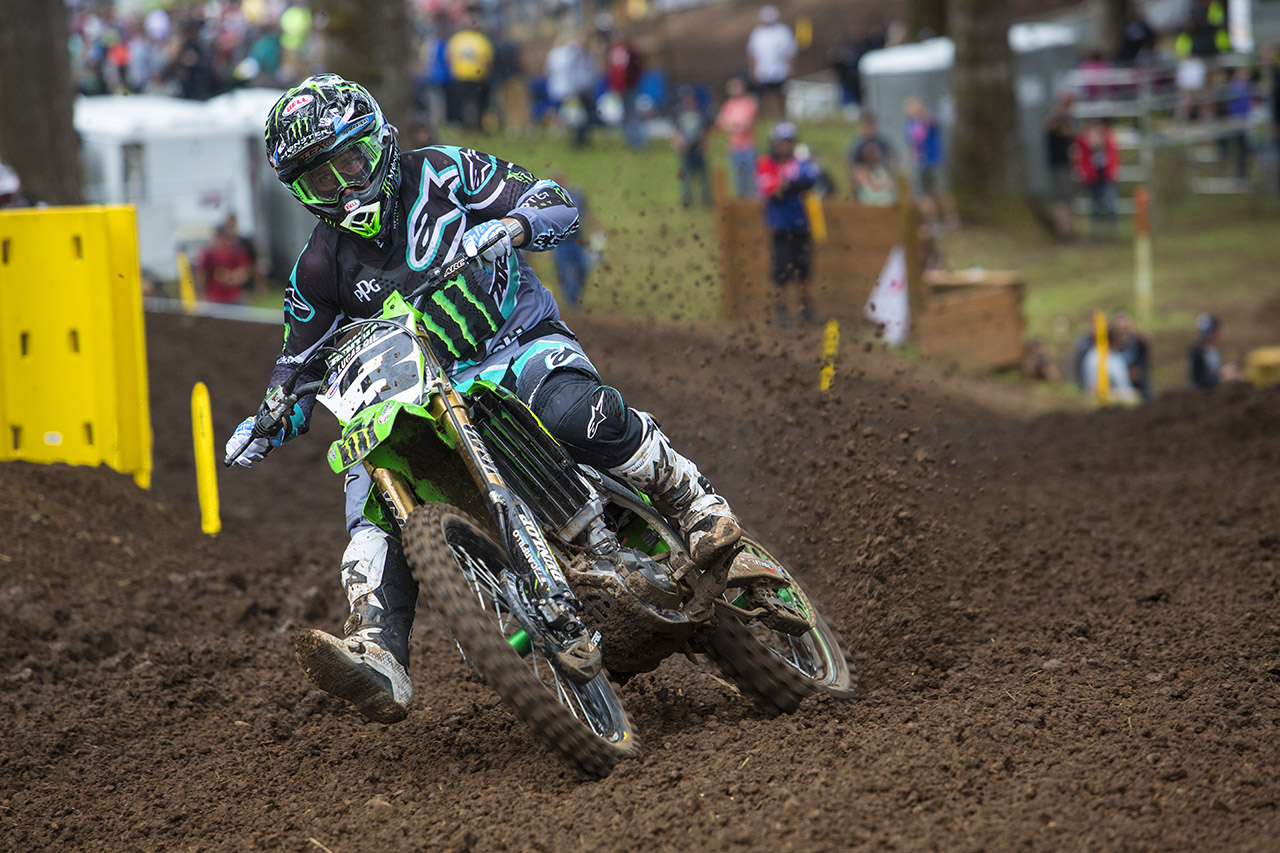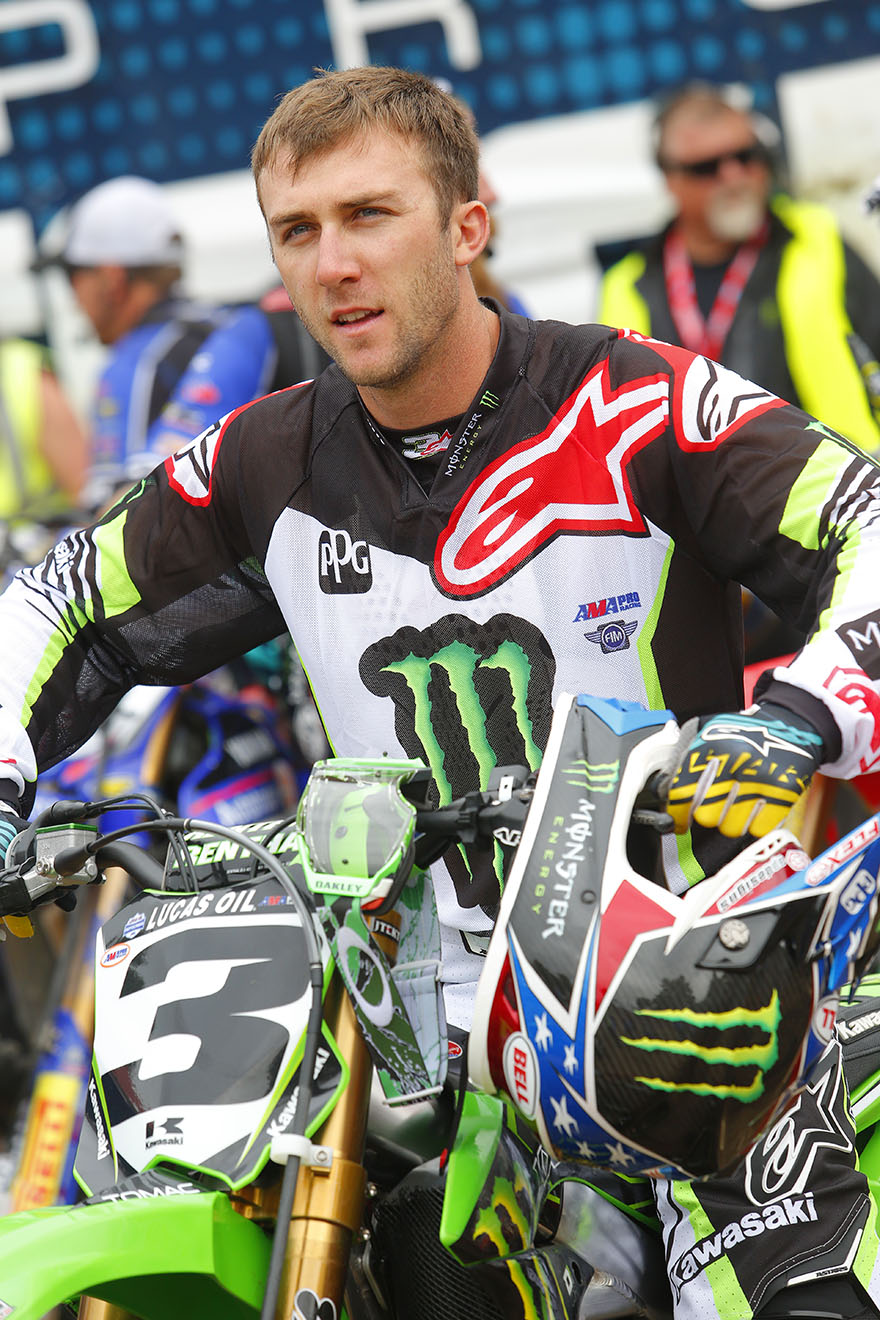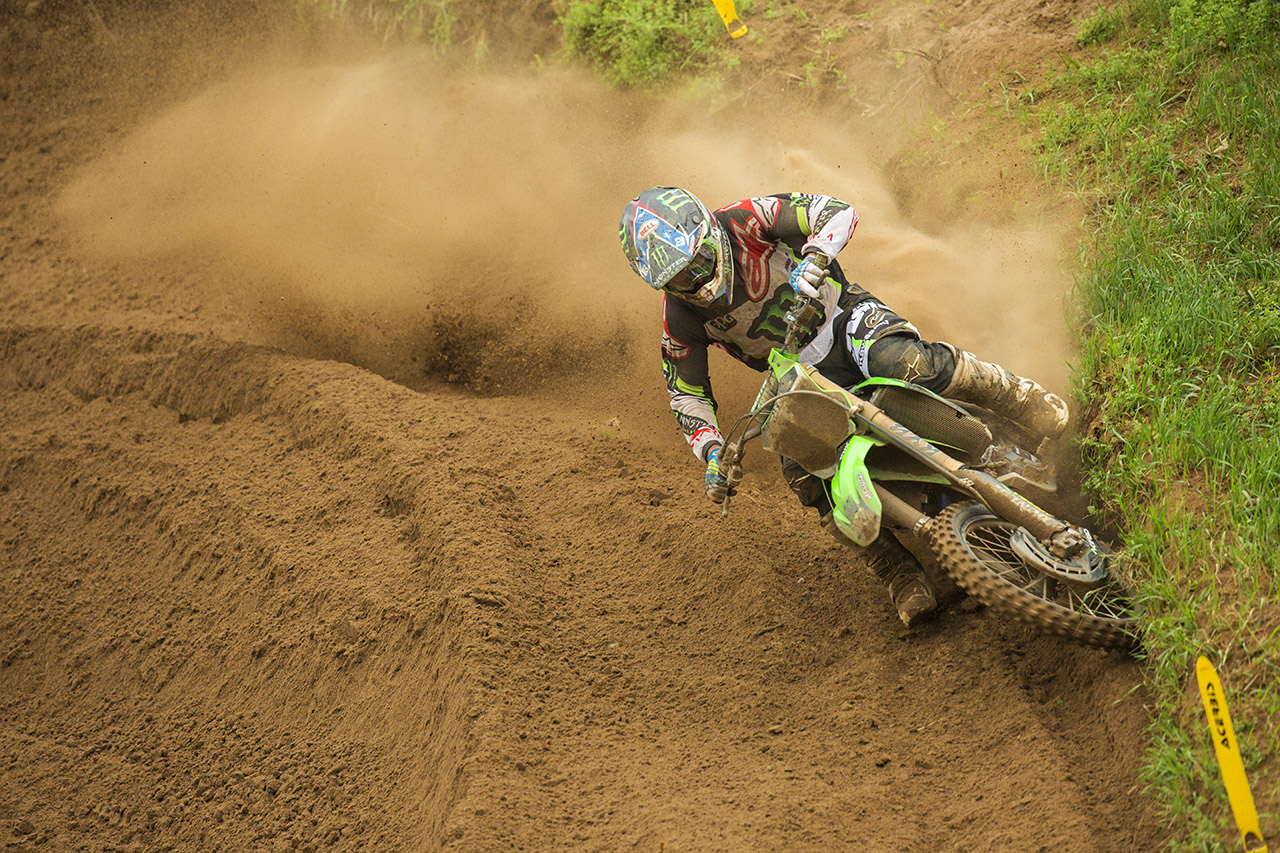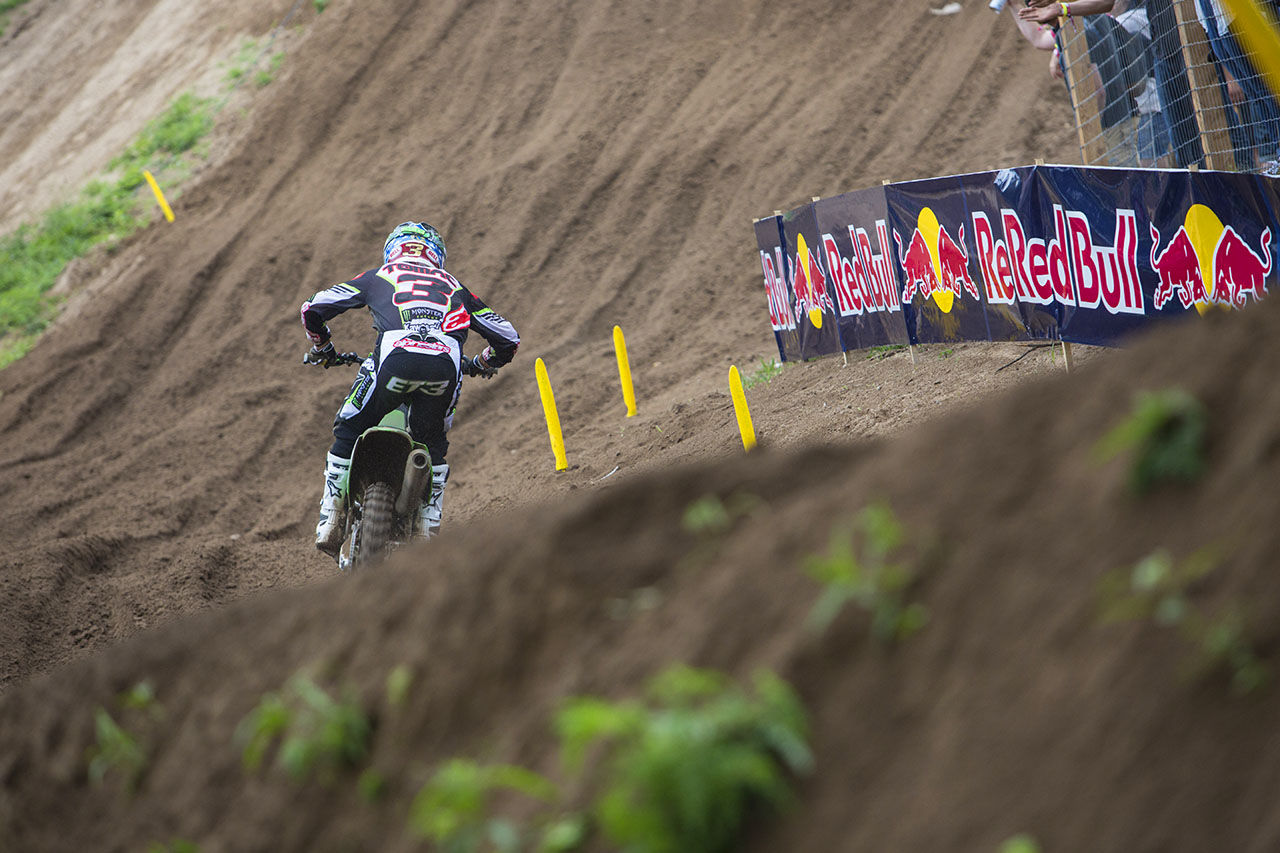INTERVIEW OF THE WEEK: KAWASAKI’S ELI TOMAC
 It’s hard not to like Monster Energy Kawasaki’s Eli Tomac. The Colorado native tries hard and trains harder than most. If you’re able to get him in a one-on-one situation, he’s quite laid back and approachable. That might not be easily understood in 2016, because Tomac hasn’t had a whole lot to smile about. He’s a fierce competitor, so when he’s not winning it would seem like the world is about to end.
It’s hard not to like Monster Energy Kawasaki’s Eli Tomac. The Colorado native tries hard and trains harder than most. If you’re able to get him in a one-on-one situation, he’s quite laid back and approachable. That might not be easily understood in 2016, because Tomac hasn’t had a whole lot to smile about. He’s a fierce competitor, so when he’s not winning it would seem like the world is about to end.
A big injury during the 2015 National knocked him out of what could have been a banner year for Eli. He was riding on rails through the first two rounds, head and shoulders above the competition. Then a freak crash ruined both shoulders and effectively ended his opportunity for a first 450 title. It was a tough pill to swallow, especially given the fact that Tomac expects nothing short of excellence out of himself. This time around, Eli is outmatched by Ken Roczen. While Tomac would be in the driver’s seat if Roczen weren’t around, that type of scenario could have been said countless times about Ken Windham. Eli Tomac wants to win championships, that much we can assure you. If you don’t believe us, read every word of this interview with the 23 year old. The factory Kawasaki rider doesn’t pull any punches.
By Anna and Jim Kimball
Photos by John Basher
 Eli, how difficult was it coming back from the double shoulder injury you sustained last year at the Colorado National? You were unstoppable in the 2015 National series before the crash.
Eli, how difficult was it coming back from the double shoulder injury you sustained last year at the Colorado National? You were unstoppable in the 2015 National series before the crash.
Going into the outdoor season last year we were obviously in a really good spot. I was comfortable and won the first two races pretty convincingly before it all went up in smoke in Colorado. I crashed myself out at Thunder Valley, and that was just a big recovery. I had to have surgery on both shoulders, which was pretty major. One was a rotator cuff surgery, and the other was surgery on my labrum. My right arm was not that hard of a recovery, yet it still took a couple of months to feel somewhat normal. The rotator cuff was the worse one and that was the one I was kind of waiting on to get better the whole time. I did not get back on the motorcycle until literally the weekend after the Monster Cup, so it was the middle of October. So from the first week of June until the middle of October, I was completely off the bike. That was my down time, and in all that same time, I transitioned to a new team and a new bike. There were a lot of things going on in my life at that point.
Were you able to do any training while recovering from those surgeries?
I was actually in two slings for 2-1/2 weeks, and just stuck in that position, so that was tough. I had to nurse each one a little bit at a time after that. It was tough for a while. You realize how one limb down is nothing, but having two limbs down is kind of a disaster. It was tough.
When you were finally cleared to get back on a bike, you were no longer with Geico Honda, but instead with Monster Energy Kawasaki. Was it difficult getting used to the new bike?
Yeah, it was a lot different feeling. It takes time to get comfortable on any dirt bike, and to get it to the final spot you want to be at. A lot of people try to find a spot that they like, but then it often takes a lot of time. It has been a building process ever since then. At least we are on the upside now and we have a couple of wins in the outdoor season. We also got a win in Supercross. The beginning of Supercross was a little bit of a roller coaster ride, but I think things kind of smoothed out since then. We are fighting for wins and in the lead pack now at least.

“I FELT LIKE I SHOULD HAVE PICKED UP WHERE I LEFT OFF. AT THE SAME TIME, I HAD TO REALIZE THAT I WAS COMING OFF AN INJURY, DIDN’T HAVE MUCH TIME ON THE BIKE, AND I ALSO SWITCHED TEAMS.”
You have a grim look on your face during the podium celebration when you don’t win. That especially held true in Supercross.
I was hard on myself because I was expecting myself to be in a better position. I am the type of guy that isn’t happy just when I am on the podium. Last year I was fighting for wins and we were really close to the winners. I felt like I should have picked up where I left off. At the same time, I had to realize that I was coming off an injury, didn’t have much time on the bike, and I also switched teams. I began to understand that I couldn’t expect to accomplish the same things I did before I was hurt. Those things take time.
You had been on a Honda for so many years, after all.
It was the change in manufacturers and it was just different, but this was a feel I was searching for. This is the motorcycle [Kawasaki] that gave me that feeling. I can’t look back now.
 Is the atmosphere at Kawasaki much different than at Honda?
Is the atmosphere at Kawasaki much different than at Honda?
No, not really. I think there are certain teams that are at a high level in our sport, and I think both teams that I have been on are on the same level. They are factory race teams, so everyone puts in all the work they can. Both teams try to get the rider the most comfortable that they can. As a rider, you are just searching for different feelings so you can have that level of comfort.
You were a step above everyone at the Daytona Supercross. How big was that win for your confidence?
It was pretty big to get that win, because in the middle of the season we were not finishing where we expected ourselves to be. I was getting fourths and fifths, and maybe a podium here and there. I did get one or two podiums before then, but I was expecting a lot more at that point. It was a sigh of relief when we won at Daytona.
Did the fact that the Daytona Supercross has motocross qualities contribute much to that win, or were you just on it?
I would say it was a little bit of both. Yes, it is kind of outdoor style, with bumps, sand and ruts. At the same time, you have your Supercross suspension on your bike, so most of the guys are running the same stuff. They are running Supercross equipment, because you still have all the triples and big rhythm sections. Those conditions suit me a little bit more, and I had a really good day there. This year’s Daytona Supercross was really important to have a good qualifying position for a good gate pick to get to the inside on the gate. I got the holeshot in the heat race and the main, so that was big.
Is it good or bad having a teammate? Most of the season you’ve been the only healthy rider on the Monster Energy Kawasaki team.
There are benefits for having a teammate. I can share thoughts on the track and sometimes bike setup, as well. I would not say having a teammate has helped my results this year, but at some point having a teammate can help a racer out. Unfortunately, I have not had a teammate the whole time, but it hasn’t had an impact on my results.
“EARLY ON I WAS SEARCHING A LOT [WITH BIKE SETUP], AND NOW WE ARE BARELY FINE-TUNING, IF ANYTHING. I’VE FOUND THAT I DO MY BEST WHEN I CAN LEAVE MY BIKE ALONE.”
At Southwick you came from behind in the first moto and blew past Ken Roczen. Then you had a good battle with Roczen in the second moto to go 1-1 on the day and win your first 450 National with Kawasaki. Describe the day in your own words.
I didn’t get a very good start in the first moto at Southwick. It was maybe top ten, or maybe even a little farther back. I had to make my way to the front, and eventually found myself at the front battling with Kenny. I made a pass in that first moto and won by a good margin. The second moto was just an all-out dogfight between Kenny and I, and I was able to come out on top at the end, even with a little tip-over. It was a fun race, and it was on a track that was kind of brutal. I loved it. I wish we had more than one track like Southwick!
Ken Roczen took the win at Millville the following weekend, but at Washougal you came right back to win again. Washougal is such a different track than Southwick.
It is very different, and it was nice to win on that type of surface. As you said, it was a totally different track. It was hard pack instead of sand, so we won on two different surfaces, which was nice. Millville was kind of disappointing, but at least we brought some fight back for Washougal.
What were your feelings on Unadilla?
I had some ups and downs, for sure. I felt I rode pretty well in the first moto, but I just couldn’t hang with the leader [Ken Roczen]. I did what I could and brought it home in second. In the second moto I didn’t get the start that I needed. With a stacked field you have to be right out front of the gate in order to be at front when the checkers fly. A third overall isn’t what we want at all. It’s time to go home, do some homework, and get this Monster Energy Kawasaki back on top of the podium!
 Do you feel pretty good with where you are in terms of bike setup?
Do you feel pretty good with where you are in terms of bike setup?
Yes, I do. I feel like if I find a good setup on the motorcycle, like with where we are at now, I can use it in all conditions. If you are fighting your setup, that is when you feel good at one track but off on another track. I believe that we are finally now at a point where I am somewhat leaving my bike alone. Early on I was searching a lot, and now we are barely fine-tuning, if anything. I’ve found that I do my best when I can leave my bike alone.
Ken Roczen and Justin Barcia have talked very openly about bike setup this season. It seems that with riders of your caliber, even minor tweaks can result in big differences that casual riders would never notice.
It is a huge deal missing your setup or feeling off. It can be the difference between going out and winning a moto by 15 seconds, or getting third. You can even see differences between motos, because someone might underperform in the first moto and then be on top in the second moto. Proper bike setup is crucial at this level, and with us racing four-strokes, it’s even more critical than it was in the past.
“OUR TRAVEL IS NOT LUXURIOUS BY ANY MEANS. WE ARE NOT ON PRIVATE PLANES LIKE OTHER PROFESSIONAL SPORTS. WE ARE ON COMMERCIAL PLANES, DEALING WITH DELAYS AND FLIGHT PROBLEMS WEEK IN AND WEEK OUT.”
You announced in the days leading up to the 2016 Motocross des Nations Team USA announcement that you were opting out of racing the event. Why?
I am racing both of the USGPs, and that will be it for me until Monster Cup. The Monster Cup is not really that far away, and missing the Motocross of Nations is nothing I ever wanted to do or say no to. But as a rider, you have to draw a line in the sand on where to say no on how many events to race a year. If I had done the Nations, it would have been 33 weeks of racing in something like 38 weekends. The schedule has gotten pretty heavy, and that has weighed on me throughout the year. I understand that as a professional athlete you are expected to perform. I do think at some point you have to say no, because I need to recover and be ready for next year.
People probably forget that Ryan Dungey bowed out of racing the MXDN last year.
Yes, that is very true. I am contracted to do so many races as it is. Of course, some people are going to give me a hard time about it, but I don’t think a lot of people realize just how much we ride during the week and how much travel we do. Our travel is not luxurious by any means. We are not on private planes like other professional sports. We are on commercial planes, dealing with delays and flight problems week in and week out. There is a lot of racing, and motocross is not easy. It is really the schedule, and the timing that was the issue for that event. I won’t be doing any overseas racing after the Monster Cup like I would have done in the past. I will be off until the 2017 Supercross series. I actually start some Supercross testing before Monster Cup to kind of get my new setup dialed in. Then I’ll be on a Supercross track testing non-stop until the beginning of January. I’ll be able to take a little time off here and there, but for the most part I’ll be on the grind.





Comments are closed.